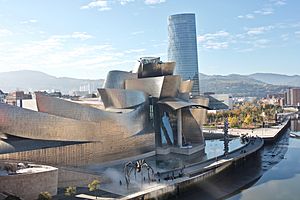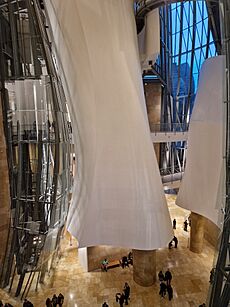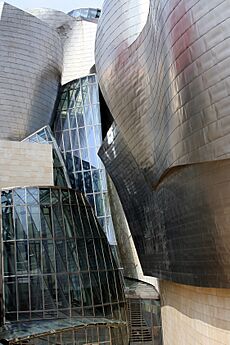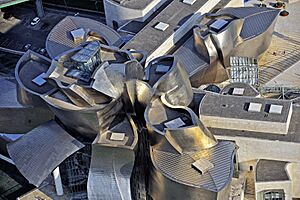Guggenheim Museum Bilbao facts for kids
| Museo Guggenheim Bilbao Guggenheim Bilbao Museoa |
|

The Guggenheim Museum Bilbao, along the Nervión Estuary in central Bilbao
|
|
| Established | 18 October 1997 |
|---|---|
| Location | Abando, Bilbao, Spain |
| Type | Art museum |
| Visitors | 1,301,343 (2024) |
| Architect | Frank Gehry |
| Public transit access | Guggenheim |
The Guggenheim Museum Bilbao is a famous museum in Bilbao, Spain. It shows modern and contemporary art. This museum is part of a group of museums connected to the Solomon R. Guggenheim Foundation. It has both permanent art pieces and special exhibits that change. You can see art by artists from Spain and all over the world here. The museum first opened on October 18, 1997. It is one of the biggest museums in Spain.
The building itself is a work of art! It was designed by a Canadian-American architect named Frank Gehry. It was built right next to the Nervion River, which flows through Bilbao to the sea. Many experts call it a "signal moment in architectural culture." This means it was a very important building that changed how people thought about architecture. It was even named one of the most important buildings built since 1980 by architecture experts in a 2010 survey.
Contents
History of the Museum
How the Museum Started
In 1991, the local government in the Basque Country suggested building a Guggenheim museum in Bilbao. They wanted to build it in an old port area that used to be very important for the city's income. The Basque government agreed to pay for the museum's construction. They also set aside money to buy new art and to help with the museum's yearly costs. In return, the Guggenheim Foundation agreed to manage the museum. They also promised to share parts of their art collection with the Bilbao museum and organize special temporary art shows.
The museum was built by a company called Ferrovial. It cost about US$89 million to build. Before the official opening, about 5,000 people from Bilbao gathered outside the museum. They enjoyed a light show and concerts. On October 18, 1997, the museum was officially opened by Juan Carlos I of Spain, who was the King at that time.
Plans for Expansion
In 2008, the Guggenheim Museum Bilbao announced plans for a new expansion. They were looking into building a 53,800 square foot (5,000 square meter) addition. This new part would be in Urdaibai, which is an estuary east of Bilbao. By 2022, the government of the Biscay province planned to put €40 million towards this expansion project.
The Amazing Building
Architecture and Design
The Solomon R. Guggenheim Foundation chose Frank Gehry to be the architect. The director of the foundation, Thomas Krens, encouraged Gehry to design something bold and new. The curves on the outside of the building might look random, but they were designed to catch the light in special ways. The inside of the museum has a large, bright open space called an atrium. This atrium offers views of Bilbao's river and the hills around the city. Gehry called this atrium "The Flower" because of its unique shape. It acts as the main center of the museum.
When the museum opened in 1997, people immediately praised it. Many called it one of the most amazing buildings in the world. Some even called it a masterpiece of the 20th century. One architect, Philip Johnson, said it was "the greatest building of our time." Another critic, Calvin Tomkins, described it as "a fantastic dream ship of undulating form in a cloak of titanium." He also said its shiny panels looked like fish scales. The museum is truly an "astonishing architectural feat."
The museum fits perfectly into the city. Its connecting shapes of stone, glass, and titanium are built on a 32,500 square meter (349,827 square foot) area along the Nervión River. While it looks modest from the street, it is most impressive when you see it from the river. The museum has a total of 24,000 square meters (258,334 square feet) of space. About 11,000 square meters (118,403 square feet) of this is for showing art. At the time it opened, this was more exhibition space than the three Guggenheim collections in New York and Venice combined!
The 11,000 square meters of exhibition space are spread across nineteen galleries. Ten of these galleries have a classic, straight-walled design. You can see these from the outside because they have stone finishes. The other nine galleries have unusual, curvy shapes. You can spot these from the outside by their swirling forms and shiny titanium covering. The largest gallery is huge, measuring 130 by 30 meters (427 by 98 feet). In 2005, this gallery displayed a massive art piece by Richard Serra called The Matter of Time.
It's quite rare for a building like this to be finished on time and within its budget. Frank Gehry explained how they did it. First, he made sure that the "organization of the artist" was in charge during construction. This prevented political or business groups from changing the design. Second, he made sure they had a very detailed and realistic cost estimate before starting. Third, they used special computer programs to create 3D models. This helped them control costs by working closely with the construction teams.
Strong Foundations
The museum building used a lot of concrete, more than 25,000 tons (10,000 cubic meters). This was needed for very deep and strong foundations. The foundation was built on reinforced concrete piles. These piles were driven into the solid rock deep underground, about 14 meters (46 feet) deep on average.
The building sits on a clay base from the nearby Estuary of Bilbao. Because of this, 665 piles had to be driven into the ground using special boring machines.
The Unique Outer Skin

The bottom part of the building is covered with beige limestone. This stone comes from quarries near Granada. The stone slabs are about 50 millimeters (2 inches) thick. The building's walls are specially treated to protect the inside from the sun's strong rays. The glass in the windows is also treated to stop light from damaging the art pieces inside.
The museum's outer skin is covered with 33,000 titanium plates. These plates are arranged like scales. Titanium was chosen instead of copper or lead because those materials can be toxic. Many tests were done with different materials to find one that could handle heat and bad weather while still looking good. That's how they discovered titanium was the best choice.
Making these titanium plates is a delicate process. It needs a lot of energy, so the plates were made in Pittsburgh, in the United States. The way they were made allowed them to be very thin, only 0.4 millimeters (0.016 inches) thick. This is much thinner than if steel plates had been used. Also, titanium is about half the weight of steel. The museum's entire titanium covering weighs only about 60 tons (132,277 pounds).
During the design phase, the pieces were shaped to resist bad weather. A quilted, rather than wavy, shape was chosen. This helps the building stand strong against the wind and prevents vibrations during storms. Titanium is also a material that causes very little pollution. Each titanium piece was designed differently based on where it would be placed on the building. This made sure they perfectly matched the curves that Gehry wanted.
Virtual Building Design
In 1993, the architects at Gehry Partners started using special computer software called CATIA. They used it to create a digital 3D model of the museum's exterior. This software could calculate the stress on different materials, showing how strong each part of the building needed to be. It helped them figure out the values for many parts of the museum, like the steel structure, the titanium covering, and the foundations. It also helped to automatically cut materials like stone or titanium plates.
The success of the Guggenheim Museum Bilbao, and how well-known it became, started a new era of "Virtual Building." This led to what is now called Building information modeling (BIM) years later. Architectural critic Paul Goldberger said that Bilbao "could not have been constructed without CATIA." He also mentioned that it was the first building where CATIA was used in almost every step of the design and construction.
Art Exhibitions
The museum displays "large-scale, site-specific works and installations by contemporary artists." This includes huge pieces like Richard Serra's 100-meter (328-foot) long Snake. It also shows art by Basque artists and a selection of works from the Guggenheim Foundation's modern art collection. When the museum first opened in 1997, it had a big show called "The Guggenheim Museums and the Art of This Century." This show featured 300 pieces of 20th-century art, from Cubism to new media art. Most of these pieces came from the Guggenheim's own collection. However, the museum also bought paintings by famous artists like Willem de Kooning and Mark Rothko. They also asked artists like Jenny Holzer and Richard Serra to create new works just for the museum.
The art exhibitions at the museum change often. The museum usually hosts shows that focus on a specific theme, like art from China or Russia. You'll find fewer traditional paintings and sculptures here. Instead, there are more installations and electronic art forms. The most important part of the museum's collection, and its only permanent exhibit, is The Matter of Time. This is a series of large sculptures made from weathering steel by Richard Serra. It's so big that it's housed in the 130-meter (427-foot) long Arcelor Gallery. The collections often highlight Avant-garde art, which is new and experimental art, as well as abstract and non-objective art from the 20th century. In 2012, an exhibition by David Hockney attracted over 290,000 visitors to the museum.
Economic and Media Impact
The museum was opened as part of a plan to make the city of Bilbao better. Almost right after it opened, the Guggenheim Bilbao became a very popular place for tourists. People came to visit it from all over the world. In its first three years, nearly 4 million tourists visited the museum. This helped create about €500 million in economic activity for the region. The local government estimated that the money visitors spent on hotels, restaurants, shops, and transportation helped them collect €100 million in taxes. This amount was more than enough to pay for the cost of building the museum!
The museum building has also appeared in movies and music videos. It was featured in the 1999 James Bond film The World Is Not Enough. It also appeared in the Tamil film Sivaji (2007) as the setting for a music video. Mariah Carey's music video for her song "Sweetheart" also shows singers Jermaine Dupri and Carey in different parts of the Guggenheim Museum Bilbao.
Images for kids
-
Tulips by Jeff Koons
-
Puppy by Jeff Koons in front of the museum
See also
 In Spanish: Museo Guggenheim Bilbao para niños
In Spanish: Museo Guggenheim Bilbao para niños
- List of works by Frank Gehry
- World Architecture Survey
- 12 Treasures of Spain
- Guggenheim family
- List of Guggenheim Museums
- List of largest art museums












